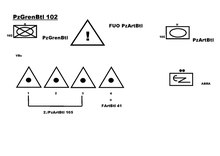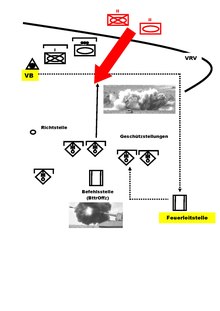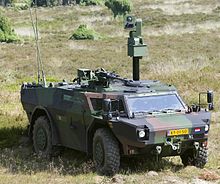Forward observer


A forward observer (VB) for mortars or artillery observer (AB) for pipe and rocket artillery (in the Swiss Army: firing commander ) is an observer who accompanies the combat troops, directs the indirect fire of the artillery and mortars for their immediate support and the battle reconnaissance the troop condensed. The Forward Air Controller (flight control officer) directs the air force's means of combat support for the army.
The VB / AB needs a good overview of the battlefield. Therefore, high buildings or towers are preferred as observation points (B-point), but also the front line of the battle . Its tasks include the monitoring of the battlefield , target reconnaissance and identification, fire control of one's own weapons and determination of the success of the effective shooting (effect investigation), the reporting of one's own observation results, the receipt and forwarding of fire requests from the combat troops as well as maintaining the connection to the Leader of the combat force with whom the observer is "dependent on cooperation" (not subordinate to).
In addition to your own eyes, observation aids and aids include various day and thermal imaging optics such as a PERI D 11 double telescope that can be swiveled through 360 degrees , a compass and a laser range finder . In addition, there are other observation options for artillery, for example through the artillery observation radar , sound measurement or drones . The light measurement during which the muzzle flash was detected is no longer carried out.
The successor to the advanced observer / artillery observer in the Bundeswehr is the Joint Fire Support Team (JFST), a coordinating element of the Armed Forces Joint Tactical Fire Support . The JFST directs not only the fire from barrel and rocket steep-angle fire but also the close air support (CAS).
function
AB artillery or VB mortars usually took up position at the front of the VRV together with the combat troops. The VB / AB. passed on his observations, which were often based on predefined target points, from the active area to the batteries in the fireplaces. The fire plan could be processed within a certain reaction time (four to six minutes for barrel artillery; ten to 25 minutes for rocket artillery). VB / AB observed the battlefield through optical observation, located targets by comparing the map / terrain and measuring the direction angle to the target. The results of this reconnaissance were passed on via radio data transmission to the fire control system ( FALKE fire control computer ) or to the battery chief of the firing artillery battery. With good visibility, optical reconnaissance depths of three to a maximum of five kilometers resulted.
The VB was one of the fire support organs that were deployed furthest forward. He was usually led from the firing battery by an officer or sergeant. A fire support officer (FUO) or artillery liaison officer (AVO) can also be involved. The crew of the M113 Optronics consisted of four men. The observation officer, auxiliary observer, radio operator and driver (MKF). The VB / AB soldiers could work both on and dismounted using a telecommunication cable.
In the early days, the artillery and tank grenadier battalions of the Bundeswehr used the armored personnel carrier for short or the converted cannon tank destroyer as an artillery observation tank or anti- tank mortar . Later the M113 GA2, or M113 Optronics, was used as a VB / AB observation tank with an observation range of 500 to 10,000 meters, a laser range finder and a vehicle navigation system. The technology for this was supplied by Thyssen-Henschel . The M113 Optronics has been used as an artillery observer in artillery battalions since 1979 . Another option since the 1990s was the M113 ABRA RATAC observation radar tank .
If the optoelectronic technology of the VB / AB fails, fire support mortars or artillery can also be requested by means of the visual stripe procedure.
Artillery observation tank M113 GA2
From 1979 to 1984 , the Bundeswehr introduced a new VB observation tank (ObPz Art) with a modernized targeting method for the tube artillery for the first time at the 45 Panzer Artillery Battalion in Göttingen . The vehicle was equipped with a double periscope (4x to 12x magnification) for recognizing and identifying targets through a laser range finder. A computer system then evaluated the measured values obtained by an optical target measurement system (OZVA), read them into a data input and output device (DEA) and passed them on to a vehicle navigation system (FNA). The FNA worked by measuring the chain revolutions and calibrating topographical points.
In order to guarantee a functioning system, the coordinates of a starting point were required. The vehicle navigation system (FNA 615) took on not only navigation, but also measurement and calculation tasks. The navigation determination was based on a direction determination ( grid north by means of a gyro compass ), a continuous automatic determination of the UTM coordinates and the calculation of the UTM coordinates ( polar coordinates ) of the measured target. The data input and output device (DEA 64) collected the necessary data for the fire commands. The innovation was the new type of radio data transmission from the VB (Advance Observer) to the fire control center, the battery chief and the guns.
The on-board test device (BPG) carried out the functional check of individual assemblies, the data check and the performance of the radio system. In the tank, the radio operator operates the DEA, the on-board test device and the vehicle radio system, consisting of an SEM 80/90 and an SEM 70 . The observer focuses on observing the battlefield . This can only happen during an observation stop. In a mobile battle, the observation tank can follow the combat troops with difficulty and serves as a target for the enemy anti-tank defense. The results of the battlefield observation depend on good visibility. This can be improved with an image intensifier telescope.
Overall, the observation enabled a target location accuracy of ± 50 meters. This in turn led to ammunition savings and time savings for new fire orders. The new ObPz enabled a new range of uses, which went beyond the previous use in defense as a dismounted and buried VB. The advantages lay in quick and precise target location over a long distance. The old operational principles of a good overview of enemy positions, camouflage and cover still retained their validity. In the attack and delay types of combat, the VB changed position while jumping. In the combined arms battle , the VB had the task of following the movement of the combat troops. The difficulty here was the low horsepower of the M113, the lack of armor protection and the high silhouette.
Operations during the battle
The VB is a fire support organ in a chain of processes between the VB - fire control - shooting battery and the combat troop unit to be supported.
When creating the operational plan of a combat troop brigade in the defense type of battle, combat support troops are “assigned” to the combat groups. The brigade artillery leader is responsible for the artillery force. The individual combat troop battalions each receive a fire support officer (FUO) to whom other advanced observers are subordinate. Together with the respective company commander, they explore their positions and change positions in order to provide effective fire support during the battle according to a pre-formulated fire plan. These can be VBs of the tank mortar, barrel or rocket artillery (e.g. LARS ).
As part of the plan of operations, various demands are made on the artillery troops. These can e.g. B. be:
- Smash enemy forces in a certain pre-defined space
- early smashing of enemy armored arms, e.g. B. by combined fire of several batteries / gun trains
- Triggering an artillery containment mine barrier (AufMiSp Art), in contrast to the Pioneers containment mine barrier (AufMiSp Pi), i. d. R. Throwing mine traps to stop or block off an enemy tank attack
- Fire support for a counterattack by brigade / battalion reserves
- Holding down dismounted enemies ( Mot-Schützen ) in a certain predefined area
The fire support by the artillery follows the different phases of the operational plan such. B. "lock" , "destroy" , "smash" , "blind" etc. Demands on the artillery can e.g. B. Individual requirements, focal points of fire (mostly barrages, "dead rooms" of the combat troops, which cannot be monitored in any other way) or others.
The batteries of the tank artillery get their pre-explored and measured batteries (mostly under cover of darkness). d. Usually camouflaged and loosened up to make enemy reconnaissance difficult. Firing positions of the artillery were high value targets Firing positions and report readiness for action.
- Observation board (target list) for the VB
| serial no. | Target no | description | Location / map pointer | height | expansion | Target value | comment |
|---|---|---|---|---|---|---|---|
| 1 | 1 | Street knee DASSENDORF | 8305 0876 | 230 | FR 1600 | E. | - |
| 2 | 2 | BORNBUSCH | 8496 0892 | 355 | - | P | from ob |
| 3 | 3 | BRAKENSTEEGE through the town | 8428 1015 | 220 | - | E. | zsl Angr |
| 4th | 4th | Kusselgelände | 8554 0995 | 270 | FR 2200 | E. | - |
| 5 | 5 | Barrage DANUBE | 8562 1155 | 220 | FR 2000 | - | right limit |
| 6th | 6th | Road fork MOHNHAUSEN | 8705 1246 | 210 | FR 1600 | - | - |
| 7th | 7th | Brick factory | 8824 1435 | 210 | FR 2000 | - | - |
Fire forms
- Fire summary: simultaneous effective shooting of several gun trains of the barrel artillery or of rocket artillery gun trains / groups.
- Disruptive fire : long-lasting, irregular fire of the tubular artillery in changing types of fire according to targets, combat criteria and use of ammunition.
- Barrage: Spatially defined effective shooting of the barrel artillery, agreed with KpfTrp, use of ammunition approx. 45 rounds of explosive or bomblet, which is fired at high rate of fire in particularly endangered areas in front of one's own troops.
- Request by VB / AB Artillery, Fighting Troop Leader from platoon leader upwards.
Types of fire tubular artillery
- Fire strike: sudden fire that is located in the target and emits at the highest rate of fire
- Group fire : 1 group = 1 shot per firing gun
- Volley fire: all guns fire at the same time
Types of fire rocket artillery
- Series fire: the rockets from all tubes of one or more rocket launchers are fired
- Partial series fire : one or more rocket launchers fire a commanded number of rockets
Terms for the intended effect of the fire
- Lockdown : Stop attacking or retreating enemy for a limited time
- Fighting: General term for fire orders when the intended effect cannot yet be determined
- Hold Down: Force the enemy into cover for a limited time and prevent them from fighting
- Blocking: prevent the enemy from quickly passing through a certain part of the terrain by firing longer effective means (mines)
- Disturbing: Disturbing the enemy, hindering his actions and doing as much harm as possible
- Destroy: To inflict such losses on the enemy that they can no longer take part in further combat operations
- Smashed: Reduce the enemy's fighting strength to such an extent that they can no longer participate in combat for a limited time
- Illuminate: Use pyrotechnic means (illum) to illuminate certain parts of the terrain in order to facilitate the fight of your own troops
- Blind: By using pyrotechnic means (fog) to prevent the enemy from seeing or participating in combat
- Surveillance: Observe a specific room and be ready to fight an enemy with fire observed as soon as it occurs
Types of ammunition in tubular artillery and their effects
- Bomb shells work with submunition ( shaped charge) primarily against lightly armored / armored targets and against people without cover (splinters).
- Explosive projectiles with proximity fuses are used against people without and in open top cover as well as against light and unarmored vehicles, unprotected equipment.
- Explosive projectiles with a percussion fuse or with delay are particularly effective against enemies in forests and in light cover.
- Explosive projectiles with concrete breaker fuses are used against expanded positions, bunkers
- Smart ammunition are used against armored targets, the projectiles are independently able to search for targets in the target area and destroy them.
Fire orders via the VB / AB
Artillery fire support is based on a specific schematic sequence:
- Data input and output device for the transmission of fire commands
- Forwarding to the fire control center via radio data transmission
- electronic conversion into corresponding fire commands
- electronic forwarding to a corresponding output device of the gun crews
The fire plans to occupy certain rooms or sections of the site with barrages are usually worked out beforehand and recorded in the corresponding operation plans. The request to fire begins when the leader of the combat troops establishes radio communication with the artillery. The fire requirement depends on the target point, combustion chamber or calling up a pre-planned barrage. In the course of combat operations, there is often a dialogue between the combat troop leader and the assigned VB. The combat troop leader requests fire support from the respective situation, the VB aims at the target, repeats this command as a target message and forwards it to his fire control officer.
"" Here leader of combat troops, target point 2001. Hold down the PAK position! Come on now, for ten minutes! ““
The target message is based on an eight-digit coordinate position, the reference point method, the baptism of the terrain or the sight stripe method determined by the compass number.
The artillery reports back:
"" Artillery here. Ready to fire, wait. Fired! Attention surcharge! ““
The communication in battle could also proceed as follows:
"" ADLER here BUSSARD. Valley depression reached before 034. BUSSARD DRS after 036. Hold down Pak Westrand 036 for five minutes. ““ Here eagle, understood, end! "VB reports:" BUSSARD, this ADLER, ready to hold down, immediately. DRS immediately, end! "."
An order to fire an artillery unit ( Bundeswehr ) can be as follows:
“ Battery boss, here VB 1. Observation center at 8515 1175, combustion chamber 1, plan pointer 851111 target height 211 target axis 2800 smashed. / Separation / Firebox 2, plan pointer 85390991, target height 270, target axis 2000 smashed. / Separation / Firebox 3, map pointer 841102, target height 225, target axis 2800 hold down. / Separation / Barrage 4, map indicator 8562 1155, target height 210, ROSE 1 between map indicator 866115 and 848117. "
Notes and individual references
- ^ Scout car Fennek JFST. Retrieved May 11, 2020 .
- ↑ double periscope
- ↑ Product information | KMW. Retrieved May 11, 2020 .
- ↑ Front Edge of Defense
- ↑ Major Eberhard Lüder: Reconnaissance by the artillery. Troop Practice. Leadership, technology and training for the Bundeswehr officer. Born in 1974.
- ↑ a b c d e f Rainer Oestmann: I order that…! Manual for military leaders. Management process up to division level. Walhalla-Verlag, 7th edition 2012. ISBN 978-380-296020-8 .
- ↑ military drivers
- ↑ the PzGrenBrig 4/ 2 PzGren assumed
- ↑ a b c d e f g OTL Hisso von Selle: Use of the advanced observer of the tank artillery with the new combat vehicle. Artillery observation tank M113 GA2 : Truppenpraxis 3/1983. Darmstadt, Wehr und Wissen publishing company.
- ↑ autonomous navigation u. Measurement system in the IFAB system network (integrated fire control equipment , artillery, battery) from Bodenseewerk Geräteechnik GmbH, Überlingen
- ↑ all pre-planned mine barriers must be approved in advance by the division
- ↑ Fire requirements / types of effects of the artillery: lock down, fight, hold down, block, destroy, smash, illuminate, blind, disrupt or monitor
- ↑ Only through the technology of integrated fire control means artillery battery (IFAB) and AURORA system (autonomous straightening and orientation equipment for tubular artillery) were measured firing positions
- ↑ no longer necessary for tank artillery
- ↑ Combat readiness of the artillery
- ↑ a b c d e Army Office: Artillery Troop Pocket Map No. 1 . April 1, 1997.
swell
- Bundeswehr: HDv 260/100. Artillery leadership. Ed .: Bundeswehr.
- Bundeswehr: regulation instruction for command and control (AnWFE) 266/200. Shooting with observation. Ed .: Bundeswehr.
- Bundeswehr pocket card no. 1. Cooperation VB-KpfTr
Web links
- M113 armored personnel carrier (Bw). Artillery observation tank M113 G A2
- Artillery in combat part 1 1/2 educational film of the Bundeswehr 1980s
- Artillery in action Part 1 2/2 Instructional film of the Bundeswehr 1980s
- Artillery in combat part 2 1/2 educational film of the Bundeswehr 1980s
- Artillery in action Part 2 2/2 Instructional film of the Bundeswehr 1980s











